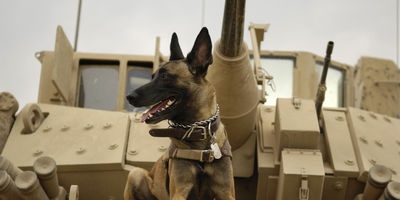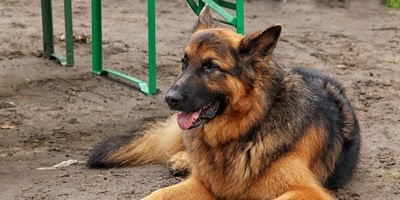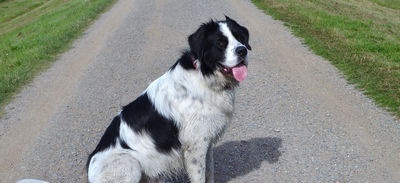|
 Many TV viewers, obviously, remember a shepherd named Sharik from the old serial Four Tankers and a Dog. The tankers considered Sharik to be a full member of their crew. Many TV viewers, obviously, remember a shepherd named Sharik from the old serial Four Tankers and a Dog. The tankers considered Sharik to be a full member of their crew.
He shared the joys and hardships with them, took a direct part in many complex military operations. Sharik was especially distinguished when it was required to establish a connection. The quick-witted dog knew how to deliver reports literally from the very hell.
It is possible that the movie hero Sharik is just a figment of the imagination of Polish filmmakers. But the dog itself as part of a tank crew is by no means an invention. During the Great Patriotic War, our tankers often picked up puppies and put them, in the language of the military, on full allowance.
According to another film - "Normandy - Niemen" - it is known that the partisans gave a puppy to a French pilot. The puppy grew up and accompanied the owner everywhere, roaming with him from airfield to airfield. And when peace came, the pilot did not want to part with his four-legged friend, and the partisan gift flew to France by plane.
Animals in war are generally not so rare.
 During the Great Patriotic War, the camel became a celebrity, which the soldiers-artillerymen lovingly called the Grasshopper. The history of his appearance in the unit remained unclear: according to some, he himself nailed to the gunners when they fed the horses with hay, others said that they “picked up” the camel on the march, and still others said that the neighboring regiment gave the Grasshopper to the artillery. This is not the point, of course. The main thing is that the ship of the desert managed to perfectly adapt to both swampy swamps and snowy front roads. On his hump, he reliably dragged boxes with shells from the warehouse to the firing position, carried either a cannon or a field kitchen and walked with the artillery guardians all the way from Stalingrad to Berlin. The grasshopper was wounded four times, and each time the soldiers took care of him, and after the end of the war he was taken to his native Kalmyk steppes. During the Great Patriotic War, the camel became a celebrity, which the soldiers-artillerymen lovingly called the Grasshopper. The history of his appearance in the unit remained unclear: according to some, he himself nailed to the gunners when they fed the horses with hay, others said that they “picked up” the camel on the march, and still others said that the neighboring regiment gave the Grasshopper to the artillery. This is not the point, of course. The main thing is that the ship of the desert managed to perfectly adapt to both swampy swamps and snowy front roads. On his hump, he reliably dragged boxes with shells from the warehouse to the firing position, carried either a cannon or a field kitchen and walked with the artillery guardians all the way from Stalingrad to Berlin. The grasshopper was wounded four times, and each time the soldiers took care of him, and after the end of the war he was taken to his native Kalmyk steppes.
An even more amazing "tractor" was in the service of the artillerymen of one of the units of the 4th Ukrainian Front, who took part in the liberation of the Askania-Nova reserve from the Nazi invaders. The soldiers, leaving these places, took a zebra with them. A striped horse was dragging a 45-millimeter gun along a road muddy from the autumn mudslide, helping the artillerymen, who were storming the Turkish Wall fortified by the Nazis, to quickly change firing positions. They brought up shells on it, evacuated the wounded to the rear. Three months of active service was listed on the zebra's certificate when sent to the zoo.
Among the many animals that man has ever recruited to participate in hostilities, there were thick-skinned giants - tamed elephants, controlled by experienced drovers.
War elephants are best known from the history of the ancient world. The legions of Alexander the Great faced them in India; the Romans first got acquainted with "living tanks" during the war with the king of Epirus Pyrrhus; elephants were also part of the army of the Carthaginians, who kept them in specially equipped elephants. Sixteen war elephants helped the Syrian king Antiochus I to repel the invasion of the Galatians; in honor of this victory, a monument was erected with an image of an elephant carved on it.
Much less, oddly enough, is known about the combat use of elephants in a time closer to us.
A huge war elephant contributed to the victory of the Ethiopians over the Italians in the historic Battle of Adua. In the summer of 1896, the Emperor of Ethiopia Menelik II sent him to St. Petersburg as a gift.
 The Asian relative of the hero of the Battle of Adua distinguished himself during the people's war for the liberation of Vietnam from the French colonialists.He transported weapons, soldiers and commanders in the jungle. The elephant was awarded an order for impeccable military service. "Demobilized" after the end of hostilities, the elephant returned to the peaceful profession of a log carrier, and later (and the elephants are reaching retirement age) was placed in the Hanoi Zoo. The Asian relative of the hero of the Battle of Adua distinguished himself during the people's war for the liberation of Vietnam from the French colonialists.He transported weapons, soldiers and commanders in the jungle. The elephant was awarded an order for impeccable military service. "Demobilized" after the end of hostilities, the elephant returned to the peaceful profession of a log carrier, and later (and the elephants are reaching retirement age) was placed in the Hanoi Zoo.
The elephant is a giant, one kind of him is capable of intimidating anyone. And can a harmless pigeon prove itself on the battlefield? It turns out that it can! Even in ancient times, people noticed the attachment of birds to their native nesting sites and an extraordinary ability to navigate in flight. If a pigeon is released any distance from home, it will still find its way back. So it can be used for communication?
In Paris, there is a monument to the carrier pigeons; some of them were awarded honorary diplomas, others were awarded orders. In the First World War, there was a case when a winged signalman with a head wounded by shrapnel and a gouged out eye managed to fly through the heavy fire of enemy batteries and deliver an urgent dispatch. And during the famous battle of Verdun, a pigeon with registration number 183 three times in one day delivered the most important reports under fire to the fort. It is not surprising that in France the most famous mail pigeons are considered national heroes.
Winged champions are sometimes indispensable, despite the rapid development of the most modern technical forms of communication. The striking incident that occurred in the spring of 1942 in the Atlantic can serve as an illustration.
An English submarine, in which there was a unique sound location equipment, went to sea to test it and was attacked by fascist aircraft. The crew only managed to transmit their coordinates by radio to the base. Fleeing from depth charges, the boat was forced to go to the bottom. The planes bombed and left, but the submarine was unable to surface, the damaged mechanisms failed.
Communication at depth did not work, and the crew of the paralyzed submarine was expecting inevitable death. The fact is that although they received a radiogram with coordinates at the base and immediately sent an entire squadron to help, it returned with nothing: the underwater currents managed to carry the boat 400 kilometers from the dive site.
 Fortunately, there were carrier pigeons on it. They were placed in a special capsule and thrown upward through a torpedo tube. Fortunately, there were carrier pigeons on it. They were placed in a special capsule and thrown upward through a torpedo tube.
A storm was raging at sea, and yet one of the birds, having covered hundreds of miles, brought the submarine's new coordinates to the base. Help came on the second day, the crew was rescued. And the British government celebrated the feat of the dove with the highest military award. They erected a bronze monument to her and forever enrolled in the crew of the rescued submarine.
There is a museum in England dedicated to the carrier pigeons that served in the British army during the first and second world wars. Its creation was initiated by the leadership of the country's air force. The museum is located at one of the Air Force bases; it contains a wealth of material telling about the use of winged signalmen for military needs, about the military merits of the most famous of them.
The dove, the feat of which the Polish newspaper Dziennik Ludowy told its readers, although not awarded the award, nevertheless fully deserved it.
It happened in Austria, near the city of Klagenfurt. Fulfilling another special mission, a winged postman thirteen kilometers from the city severely damaged his wing and made an emergency landing. He could not rise again. And then the pigeon set off on foot for many kilometers. Imagine the pigeon steps and try to estimate how many of them the persistent bird had to take to overcome the huge distance! Completely exhausted, exhausted carrier pigeon with great delay, but still reached the final destination of his dramatic journey. The letter was delivered to the addressee.
Krasnopevtsev V.P. - Seagulls on a pedestal
|
 Many TV viewers, obviously, remember a shepherd named Sharik from the old serial Four Tankers and a Dog. The tankers considered Sharik to be a full member of their crew.
Many TV viewers, obviously, remember a shepherd named Sharik from the old serial Four Tankers and a Dog. The tankers considered Sharik to be a full member of their crew. During the Great Patriotic War, the camel became a celebrity, which the soldiers-artillerymen lovingly called the Grasshopper. The history of his appearance in the unit remained unclear: according to some, he himself nailed to the gunners when they fed the horses with hay, others said that they “picked up” the camel on the march, and still others said that the neighboring regiment gave the Grasshopper to the artillery. This is not the point, of course. The main thing is that the ship of the desert managed to perfectly adapt to both swampy swamps and snowy front roads. On his hump, he reliably dragged boxes with shells from the warehouse to the firing position, carried either a cannon or a field kitchen and walked with the artillery guardians all the way from Stalingrad to Berlin. The grasshopper was wounded four times, and each time the soldiers took care of him, and after the end of the war he was taken to his native Kalmyk steppes.
During the Great Patriotic War, the camel became a celebrity, which the soldiers-artillerymen lovingly called the Grasshopper. The history of his appearance in the unit remained unclear: according to some, he himself nailed to the gunners when they fed the horses with hay, others said that they “picked up” the camel on the march, and still others said that the neighboring regiment gave the Grasshopper to the artillery. This is not the point, of course. The main thing is that the ship of the desert managed to perfectly adapt to both swampy swamps and snowy front roads. On his hump, he reliably dragged boxes with shells from the warehouse to the firing position, carried either a cannon or a field kitchen and walked with the artillery guardians all the way from Stalingrad to Berlin. The grasshopper was wounded four times, and each time the soldiers took care of him, and after the end of the war he was taken to his native Kalmyk steppes. The Asian relative of the hero of the Battle of Adua distinguished himself during the people's war for the liberation of Vietnam from the French colonialists.He transported weapons, soldiers and commanders in the jungle. The elephant was awarded an order for impeccable military service. "Demobilized" after the end of hostilities, the elephant returned to the peaceful profession of a log carrier, and later (and the elephants are reaching retirement age) was placed in the Hanoi Zoo.
The Asian relative of the hero of the Battle of Adua distinguished himself during the people's war for the liberation of Vietnam from the French colonialists.He transported weapons, soldiers and commanders in the jungle. The elephant was awarded an order for impeccable military service. "Demobilized" after the end of hostilities, the elephant returned to the peaceful profession of a log carrier, and later (and the elephants are reaching retirement age) was placed in the Hanoi Zoo. Fortunately, there were carrier pigeons on it. They were placed in a special capsule and thrown upward through a torpedo tube.
Fortunately, there were carrier pigeons on it. They were placed in a special capsule and thrown upward through a torpedo tube.









